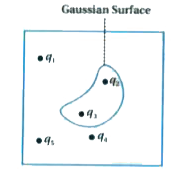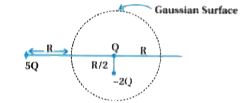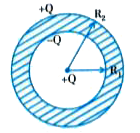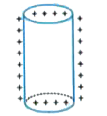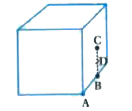SECTION C NCERT EXEMPLAR SOLUTION (LONG ANSWER TYPE QUESTIONS) from KUMAR PRAKASHAN KENDRA PHYSICS (GUJRATI ENGLISH) ELECTRIC CHARGES AND FIELDS for Class 12
| Class 12 | PHYSICS |
| Chapter | ELECTRIC CHARGES AND FIELDS |
| KUMAR PRAKASHAN KENDRA PHYSICS (GUJRATI ENGLISH) | SECTION C NCERT EXEMPLAR SOLUTION (LONG ANSWER TYPE QUESTIONS) |
| Medium | English |
| Academic Year | 2023-2024 |
Question 20
A paisa coin is made up of Al-Mg alloy and weighs 0.75 g. It has a square shape and its diagonal measures 17 mm. It is electrically neutral and contains equal amounts of positive and negative charges.
Treating the paisa coins made up of only Al, find the magnitude of equal number of positive and negative charges. What conclusion do you draw from this magnitude ? View SolutionQuestion 21
Consider a coin of Question 20. It is electrically neutral and contains equal amounts of positive and negative charge of magnitude 34.8 kC. Suppose that these equal charges were concentrated in two point charges separated by:
(i) 1 cm (−12)× displacement of the one paisa coin)
(ii) 100 m (-length of a long building)
(iii) 106 m (radius of the earth).
Find the force on each such point charge in each of the three cases. What do you conclude from these results ?View SolutionQuestion 22
Figure represents a crystal unit of cesium chloride, CsCl. The cesium atoms, represented by open circles are situated at the corners of a cube of side 0.40nm, whereas a CI atom is situated at the centre of the cube. The Cs atoms are deficient in one electron while the CI atom carries an excess electron.
(i) What is the net electric field on the CI atom due to eight Cs atoms ?
(ii) Suppose that the Cs atom at the corner A is missing. What is the net force now on the CI atom due to seven remaining Cs atoms ?
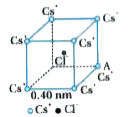 View Solution
View SolutionQuestion 24
Figure shows the electric field lines around three point charges A, B and C.

(a) Which charges are positive ?
(b) Which charge has the largest magnitude ? Why ?
In which region or regions of the picture could the electric field be zero ? Justify your answer.
(i) Near A, (ii) Near B
(iii) Near C, (iv) Nowhere View SolutionQuestion 25
Five charges, q each are placed at the corners of a regular pentagon of side 'a' as in figure:

(a) (i) What will be the electric field at O, the centre of the pentagon ?
(ii) What will be the electric field at O if the charge from one of the corners (say A) is removed ?
(iii) What will be the electric field at O if the charge q at A is replaced by -q ?
(b) How would your answer to (a) be affected if pentagon is replaced by n-sided regular polygon with charge q at each of its corners ?View SolutionQuestion 26
In 1959 Lyttleton and Bondi suggested that the expansion of the Universe could be explained il matter carried a net charge. Suppose that the Universe is made up of hydrogen atoms with a number density N, which is maintained a constant. Let the charge on the proton be : ep=−(1+y)e where e is the electronic charge.
(a) Find the critical value of y such that expansion may start.
(b) Show that the velocity of expansion is proportional to the distance from the centre.View SolutionQuestion 27
Consider a sphere of radius R with charge density distributed as :
ρ(r)=kr,r≤R
=0 for r>R
(a) Find the electric field at all points r.
(b) Suppose the total charge on the sphere is 2e where e is the electron charge. Where can two protons be embedded such that the force on each of them is zero. Assume that the introduction of the proton does not alter the negative charge distribution.View SolutionQuestion 28
Two fixed, identical conducting plates (a and (3), each of surface area S are charged to - Q and q, respectively, where Q > q > 0. A third identical plate (λ ), free to move Is located on the other side of the plate with charge q at a distance d as per figure. The third plate is released and collides with the plate f3 . Assume the collision is elastic and the time of collision is sufficient to redistribute charge amongst β and γ.
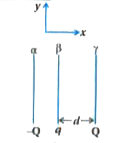
(a) Find the electric field acting on the plate γ before collision.
(b) Find the charges on β and γ after the collision.
(c) Find the velocity of the plate γ after the collision and at a distance d from the plate βView SolutionQuestion 29
There is another useful system of units, besides the SI/mKs. A system, called the cgs (centimeter-gram-second) system. In this system Coloumb's law is given by →F=Qqr2.ˆr where the distance is measured in cm (=10−2m), F in dynes (=10−5 N) and the charges in electrostatic units (es units), where 1 es unit of charge 13×10−9C.
The number [3] actually arises from the speed of light in vacuum which is now taken to be exactly given by c=2.99792458×108 m/s. An approximate value of c then is c=[3]×108 m/s.
(i) Show that the coloumb law in cgs units yields 1 esu of charge = 1 (dyne) 1/2 cm. Obtain the dimensions of units of charge in terms of mass M, length L and time T. Show that it is given in terms of fractional powers of M and L.
(ii) Write 1 esu of charge = x C, where x is a dimensionless number. Show that this gives:
14πε0=10−9x2Nm2C2 with x=13×10−9, we have 14πε0=[3]2×109Nm2C2 or 14πε0=(2.99792458)2×109Nm2C2 (exactly). View SolutionQuestion 30
Two charges -q each are fixed separated by distance 2d. A third charge q of mass m placed at the midpoint is displaced slightly by x (x < < d) perpendicular to the line joining the two fixed charged as shown in figure. Show that q will perform simple harmonic oscillation of time period. T=[8π3ε0md3q2]1/2
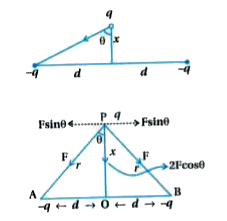 View Solution
View SolutionQuestion 31
Total charge - Q is uniformly spread along length of a ring of radius R. A small test charge +q of mass m is kept at the centre of the ring and is given a gentle push along the axis of the ring.
(a) Show that the particle executes a simple harmonic oscillation.
(b) Obtain its time period.
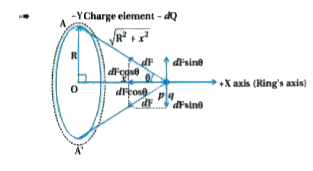 View Solution
View Solution
All Exercises from KUMAR PRAKASHAN KENDRA PHYSICS (GUJRATI ENGLISH) Class 12 PHYSICS ELECTRIC CHARGES AND FIELDS
- SECTION A QUESTIONS- ANSWERS
- SECTION A QUESTIONS- ANSWERS ( HIGHER ORDER THINKING SKILLS (HOTS) UNIFICATION OF ELECTRICITY AND MAGNETISM)
- SECTION A QUESTIONS- ANSWERS (ADDITIVITY OF CHARGES)
- SECTION A QUESTIONS- ANSWERS (APPLICATION OF GAUSS.S LAW)
- SECTION A QUESTIONS- ANSWERS (BASIC PROPERTIES OF ELECTRIC CHARGE)
- SECTION A QUESTIONS- ANSWERS (CHARGE IS CONSERVED)
- SECTION A QUESTIONS- ANSWERS (CHARGING BY INDUCTION)
- SECTION A QUESTIONS- ANSWERS (CONDUCTORS AND INSULATORS)
- SECTION A QUESTIONS- ANSWERS (CONTINOUS CHARGE DISTRIBUTION)
- SECTION A QUESTIONS- ANSWERS (COULOMB.S LAW)
- SECTION A QUESTIONS- ANSWERS (DIPOLE IN UNIFORM EXTERNAL FIELD)
- SECTION A QUESTIONS- ANSWERS (ELECTRIC DIPOLE)
- SECTION A QUESTIONS- ANSWERS (ELECTRIC FIELD LINES)
- SECTION A QUESTIONS- ANSWERS (ELECTRIC FLUX)
- SECTION A QUESTIONS- ANSWERS (FIELD DUE TO A UNIFORMLY CHARGED THIN SPHERICAL SHELL)
- SECTION A QUESTIONS- ANSWERS (FIELD DUE TO AN INFINITELY LONG STRAIGHT UNIFORMLY CHARGED WIRE)
- SECTION A QUESTIONS- ANSWERS (FIELD DUE TO AN UNIFORMLY CHARGED INFINITE PLANE SHEET)
- SECTION A QUESTIONS- ANSWERS (FORCES BETWEEN MULTIPLE CHARGES)
- SECTION A QUESTIONS- ANSWERS (GAUSS.S LAW)
- SECTION A QUESTIONS- ANSWERS (PHYSICAL SIGNIFICANCE OF DIPOLES)
- SECTION A QUESTIONS- ANSWERS (THE FIELD OF AN ELECTRIC DIPOLE)
- SECTION A QUESTIONS- ANSWERS (TRY YOURSELF )
- SECTION B NUMERICALS (ADDITONAL EXERCISE)
- SECTION B NUMERICALS (NUMERICAL FOR .DARPAN. BASED ON TEXTBOOK)
- SECTION B NUMERICALS (NUMERICAL FROM TEXTUAL EXERCISES)
- SECTION B NUMERICALS (NUMERICAL FROM TEXTUAL ILLUSTRATIONS)
- SECTION C NCERT EXEMPLAR SOLUTION (LONG ANSWER TYPE QUESTIONS)
- SECTION C NCERT EXEMPLAR SOLUTION (MULTIPLE CHOICE QUESTIONS (MCQS))
- SECTION C NCERT EXEMPLAR SOLUTION (MULTIPLE CHOICE QUESTIONS (MORE THAN ONE OPTION))
- SECTION C NCERT EXEMPLAR SOLUTION (SHORT ANSWER TYPE QUESTIONS)
- SECTION C NCERT EXEMPLAR SOLUTION (VERY SHORT ANSWER TYPE QUESTIONS)
- SECTION D (MULTIPLE CHOICE QUESTIONS (MCQS)) (MCQS FROM .DARPAN. BASED ON TEXTBOOK) (ASSERTION AND REASON TYPE MCQS)
- SECTION D (MULTIPLE CHOICE QUESTIONS (MCQS)) (MCQS FROM .DARPAN. BASED ON TEXTBOOK) (CONTINUOUS DISTRIBUTION OF CHARGE AND ELECTRIC FLUX)
- SECTION D (MULTIPLE CHOICE QUESTIONS (MCQS)) (MCQS FROM .DARPAN. BASED ON TEXTBOOK) (ELECTROSTATIC ELECTRIC CHARGE AND FRICTIONAL ELECTRICAL CHARGE)
- SECTION D (MULTIPLE CHOICE QUESTIONS (MCQS)) (MCQS FROM .DARPAN. BASED ON TEXTBOOK) (LECTRIC FIELD AND ELECTRIC DIPOLE)
- SECTION D (MULTIPLE CHOICE QUESTIONS (MCQS)) (MCQS FROM .DARPAN. BASED ON TEXTBOOK) (MISCELLANEOUS MCQS)
- SECTION D MCQS ASKED IN COMPETITIVE EXAMES (MCQS AKSED IN BOARD EXAM AND GUJCET)
- SECTION D MCQS ASKED IN COMPETITIVE EXAMES (MCQS ASKED IN AIEEE AND JEE MAINS)
- SECTION D MCQS ASKED IN COMPETITIVE EXAMES (MCQS ASKED IN CBSE-PMT AIPMT NEET)






